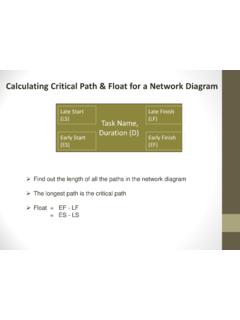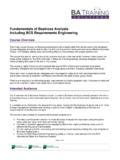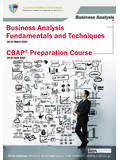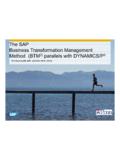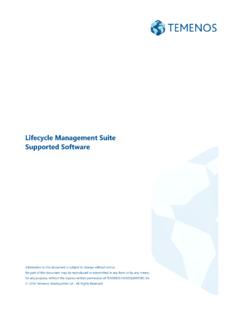Transcription of HP Application Lifecycle Management (ALM) - Free PM Study
1 HP Application Lifecycle Management (ALM) Knowledge Share Maheshwar Salendra Date : 12/02/2012 ALM 2 ALM AGENDA: Introduction to ALM ALM Functionality by Edition ALM Home page Side bars: Management Requirements Testing Defects Dashboard Introduction to Sprinter Sprinter Functionality 3 ALM ALM is the new Test Management Tool which was released by HP in Nov 2010 and now it is the widely used tool in Organizations. It is an advanced version of Quality Center and generally considered as QC ALM provides a system control over the process by organizing and tracking Application releases enabling you to align your business priorities and quality expectations with your project requirements, tests, and defects. It also allows you to share defects across projects, reducing risk by helping developers find, prioritize, and resolve defects sooner.
2 A centralized defect repository also enables reporting of aggregated defect status and trends across projects. ALM offers integration with HP testing tools (for example, QuickTest Professional and LoadRunner) as well as third-party and custom testing tools, and requirement and configuration Management tools. ALM communicates with the testing tool of your choice, providing you with a complete solution to fully automated Application testing. Introduction to ALM 4 ALM ALM Functionality by Edition HP Application Life Cycle Management (ALM ) is available in three editions which provide subsets of ALM functionality HP Quality Center Starter Edition HP Quality Center Enterprise Edition HP ALM Performance Center Edition 5 ALM 6 ALM 7 ALM 8 ALM ALM Home Page 9 ALM Masthead Sidebars 10 ALM Management Most applications require testing on multiple hardware platforms, multiple configurations (computers, operating systems, and browsers), and multiple Application versions.
3 Managing all aspects of an Application release can be time-consuming and difficult. You begin the Application Management process by defining releases. HP Application Lifecycle Management (ALM) enables you to organize and track your upcoming releases by defining releases and cycles. In the Libraries module, you define a hierarchical libraries tree to create and manage your libraries. 11 ALM Management Sidebar: Note : Release/Libraries Module is not available in Quality Center Starter Edition has two sub-tabs: Releases: A release represents a group of changes in one or more applications that will be available for distribution at the same time. Each release can contain a number of cycles. A cycle is a set of development and quality assurance efforts performed to achieve a common goal based on the release timeline. Both releases and cycles have defined start and end dates.
4 12 ALM Management Sidebar: Libraries : A library represents a set of entities in a project and the relationships between them. The entities in a library can include requirements, tests, test resources, and business components. After you create a library, you can create a baseline to keep track of changes made to your project over time. A baseline is a snapshot of the library at a specific point in time. You can compare baselines at all stages of the Application development Lifecycle . 13 ALM Requirements Requirements Sidebar: has two tabs: Requirements: The requirements tree is a graphical representation of your requirements specification, displaying the hierarchical relationship between different requirements. The tree includes different groups of requirements based either on requirement type or functional area.
5 For each requirement group, you create a list of detailed requirements in the requirements tree. Each requirement in the tree is described in detail and can include any relevant links and attachments. After creating a requirements tree, the requirements can be used as a basis for defining tests in your test plan tree. 14 ALM Requirements Sidebar: business Models: The HP Application Lifecycle Management (ALM) business Models module addresses the need for a stronger connection between business process modeling, quality assurance Management , and requirement definitions. The module integrates business process models into the Application Lifecycle . Integrating business process models into ALM involves importing business process models into ALM, and linking requirements and tests to models, activities and end-to-end business flows. After executing tests, you can display quality status views on the business process model level.
6 Note: To work with business process models in ALM, you must first have created models in standard BPMN or EPC modeling tools, and exported them to files. ALM supports the following model and file formats: BPMN models exported to XPDL files EPC models exported to AML files (.xml extension) 15 ALM Testing Testing Sidebar: It has 4 sub tabs: Test Plan: After you add a test to the test plan tree, you build the test by defining design steps. After you define the test steps, decide whether to perform the test manually or to automate it. For manual tests you define steps, execute them on your Application , and record the results of each step. Manual tests include usability tests, onetime tests, tests that need to be run immediately, tests requiring knowledge of the Application , and tests without predictable results. 16 ALM Testing Sidebar: Test Lab: A test set contains a subset of the tests in an HP Application Lifecycle Management (ALM) project designed to achieve specific test goals.
7 As your Application changes, you run the manual and automated tests in your project in order to locate defects and assess quality. You can run ALM tests manually or automatically: Running Tests Manually You can run tests manually in ALM using: HP Sprinter: Sprinter provides enhanced functionality to assist you in the manual testing process. ALM Editions: Sprinter functionality is not available with Quality Center Starter Edition and Performance Center Edition. Manual Runner: If you are not working with Sprinter, you can run tests manually using Manual Runner. You can run manual and automated tests manually in ALM. When you run a test manually, you follow the test steps and perform operations on the Application under test. You pass or fail each step, depending on whether the actual Application results match the expected output. 17 ALM Sprinter: Sprinter provides advanced functionality and tools to make manual testing more efficient and effective.
8 Sprinter enables you to accomplish these tasks without disrupting your test flow. With Sprinter, you can also perform many of the repetitive and tedious tasks of manual testing automatically. Sprinter includes many tools to help you detect and submit defects. These features ensure that you can perform all the tasks necessary for your manual test with minimum interruptions to your testing work. With Sprinter you can: User-friendly display Move easily between tests in your run Edit actual values of parameters during your test run Multiple views Actual value including screen captures Create and annotate screen captures of your Application Record and run macros on your test Application Inject data Replicate your actions on another computer 18 ALM Sprinter - Steps: When we run manual steps through sprinter it arranges all the necessary tools along the broader of AUT page and develops user-friendly environment for testing.
9 Sprinter accelerates manual testing process. We can execute each step directly by implementing on the Application and update the actual result. 19 ALM Sprinter Steps(Sub- titles): Sprinter enables user to have test steps in sub-titles format. It provides a provision to execute the test steps, update actual results and raise defects upon failure. 20 ALM Sprinter Data Injection: Using Sprinter we can inject test data into the Application by matching column names with the field names with the Application . We can inject multi set of data directly into the Application with corresponding matching fields at one go. Select the row which you want to inject and click on the inject icon which directly injects the data into the corresponding fields. 21 ALM 22 ALM 23 ALM Sprinter Macros: This is an excellent feature in ALM which reduces 80% of the human effort in execution just with one click.
10 Sprinter provides a feature to record Marcos for all the manual execution activity which you are doing. When we run the macro it replicates the activity which we have done previously and can be widely used for regression. 24 ALM Sprinter Run Control: This sidebar enables you to set the status of your test and move between the different tests in the list of tests you are running. It enables you to record the user actions performed while executing tests, display test details and has a provision to stop the test. 25 ALM Sprinter Tools: Sprinter provides tools that enable you to detect defects in your Application and report them to HP ALM. These tools allow you to detect and report defects without disrupting the test flow. Sprinter defect detecting tools enable you to examine the display of the Application being tested, for defects such as alignment, spacing, and color usage.
